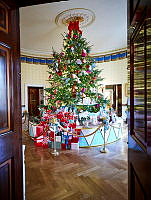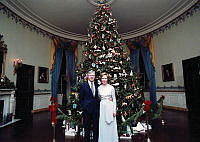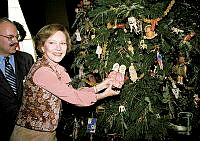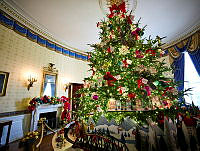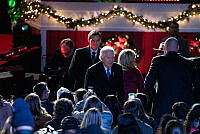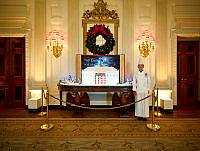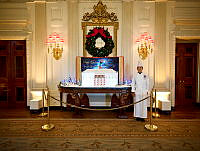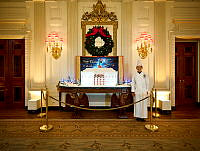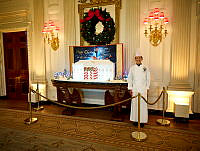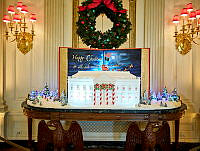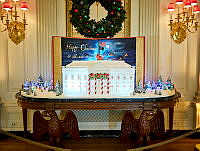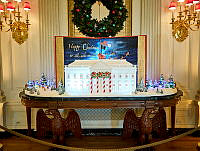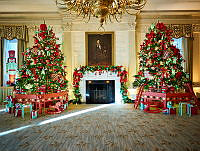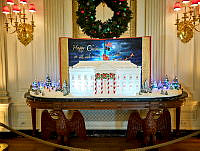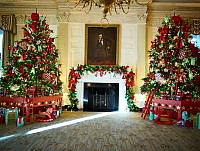Rubenstein Center Scholarship
The Life and Presidency of Jimmy Carter
The Official 2024 White House Christmas Ornament Historical Essay

President Jimmy Carter’s official portrait was made by artist Herbert Abrams in 1982 and is displayed in the White House today.
White House Collection/White House Historical AssociationJames Earl Carter Jr. was born on October 1, 1924, in the small rural town of Plains, Georgia, about 150 miles south of Atlanta. His father, James Sr., was a businessman and farmer. His mother, known to the nation as Miss Lillian during her son’s presidency, was a nurse who served as a Peace Corps volunteer after her children were grown and wrote several books about her experiences, her faith, and her family. The future president was called Jimmy; he was the eldest of four children, attended public school, and worked to help his family financially. Before being admitted to the United States Naval Academy, he attended Georgia Southwestern College and the Georgia Institute of Technology. In 1946, Carter graduated from the Naval Academy, and on July 7, he married Eleanor Rosalynn Smith, also of Plains, whom he first met at age three and first dated in college. Married for more than seventy-five years, Rosalynn and Jimmy have four children: John William (“Jack”), James Earl III (“Chip”), Donnel Jeffrey (“Jeff”), and Amy Lynn.1
After graduation, Ensign Carter signed up for submarine duty. He had interests in science and engineering and became familiar with nuclear physics and reactor technology. In 1949 he was promoted to the rank of lieutenant, junior grade, and in 1952 promoted again to the rank of lieutenant. In 1953, as he prepared to serve on the USS Seawolf, his father’s death prompted Carter to resign from the navy and return to Plains.2 There he took over the Carter farms and built a warehouse business, working along-side Rosalynn and other family members. Now famous for their peanut crops, the future president’s family farms also cultivated corn, cotton, and sugarcane. Carter became a community leader in Plains and beyond, serving on several county boards before he was elected to the Georgia Senate in 1962.

Jimmy Carter takes the Oath of Office, January 20, 1977.
Jimmy Carter Presidential Library and Museum/NARAIn 1966, Carter ran in the Democratic gubernatorial primary but lost; he ran again in 1970 and won both the nomination and election, becoming Georgia’s seventy-sixth governor. Carter pledged to run the government like his family business, “in an honest and efficient manner.” He also spoke bluntly about prejudice: “The time for racial discrimination is over. . . . No poor, rural, weak, or black person should ever have to bear the additional burden of being deprived of the opportunity of an education, a job or simple justice.”3 Carter promised to reorganize state agencies to make government more accountable to the people. These reforms became the foundation for Carter’s presidential campaign.
Carter secured his party’s nomination for president on the first ballot in 1976, and that fall he narrowly defeated President Gerald R. Ford. In his Inaugural Address, President Carter spoke of “a new spirit among us all,” calling on citizens to work together for the common good. “We have already found a high degree of personal liberty, and we are now struggling to enhance equality of opportunity. Our commitment to human rights must be absolute, our laws fair, our national beauty preserved; the powerful must not persecute the weak, and human dignity must be enhanced,” he remarked.4 The president’s emphasis on human and civil rights foreshadowed his domestic programs, foreign policy decisions, cabinet nominations, and judicial appointments. He appointed more women to his cabinet than any of his predecessors, and more women and people of color to the federal judiciary than all previous presidents combined.5
President Carter reorganized and consolidated executive branch agencies, and he advocated for two new departments—the Department of Energy and the Department of Education. His proposals resulted in comprehensive civil service reform, an emphasis on renewable energy, and federal protection of more than 100 million acres of land. President Carter’s focus on accountability also extended abroad as he challenged both allies and foes on their human rights records. His fundamental commitment to peace and democratic values resulted in several foreign policy achievements.
President Carter negotiated the Torrijos-Carter Treaties, which set in motion the return of the Panama Canal to Panama.6 He signed a nuclear arms agreement (SALT II) with Leonid Brezhnev of the Soviet Union. While the Soviet invasion of Afghanistan complicated this pact, both countries largely adhered to its terms. But perhaps President Carter’s most significant accomplishment was the Camp David Accords. For nearly two weeks in September 1978, the president moved back and forth between delegations at Camp David, the presidential retreat in Maryland. The parties agreed on the general framework for peace, but it would take several more months of negotiations before President Anwar Sadat of Egypt and Prime Minister Menachem Begin of Israel signed the Egypt-Israel Peace Treaty on the North Lawn of the White House on March 26, 1979.7
President Carter also faced major economic challenges at home. Unemployment and interest rates remained high, and inflation continued to climb. After entering office, President Carter signed a stimulus package to boost the economy; he also argued that reforming the regulatory system would reduce costs, lower prices, and benefit households across the country. Carter’s deregulation of the airline, savings and loan, transportation, and telecommunication industries spurred new investment, increased competition, and gave consumers more choices.
In February 1979, Iranian revolutionaries deposed the U.S.- backed shah of Iran. Nine months later, Iranians stormed the U.S. Embassy in Tehran, holding more than fifty Americans hostage for 444 days.8 A mix of economic, military, and diplomatic tactics were used to secure their release, but it took more than a year to bring the Americans home. The duration of the Iranian Hostage Crisis, along with double digit inflation and high interest rates, contributed to Carter’s landslide defeat by Republican presidential candidate Ronald Reagan in 1980. On Inauguration Day, President Carter was still working to finalize the release of the hostages. Shortly after President Reagan took the Oath of Office, fifty-two Americans were airborne and former President Carter left Washington to meet them in West Germany.9

Jimmy Carter dedicates energy-saving solar panels on the West Wing, 1979.
Jimmy Carter Presidential Library and Museum/NARAAfter their time in the White House, the Carters founded the Carter Center in 1982. Their global initiatives—to eradicate disease; encourage free and fair elections; improve public health and minimize stigma against people with mental illnesses; and mediate conflict were rooted in their lifelong commitment to human rights and peaceful coexistence.10 The former president also published more than thirty books about his life, vision, and the quest for world peace, and, until 2020, he continued to teach a weekly Sun-day School class at Maranatha Baptist Church in Plains, to which the public was welcomed. In 2002, Jimmy Carter was awarded the Nobel Peace Prize. In his acceptance speech, he said:
The bond of our common humanity is stronger than the divisiveness of our fears and prejudices. God gives us the capacity for choice. We can choose to alleviate suffering. We can choose to work together for peace. We can make these changes—and we must.11

First Lady Rosalynn Carter joins her husband in a historic walk down Pennsylvania Avenue to the White House following his Inauguration at the Capitol, January 20, 1977.
Jimmy Carter Presidential Library and Museum/NARAFirst Lady Rosalynn Carter
Following his 1977 Inauguration ceremony, President Carter and First Lady Rosalynn Carter walked down Pennsylvania Avenue hand in hand. This walk symbolized how the pair would operate both in the White House and for the rest of their lives—as equal partners. As first lady, Mrs. Carter shaped and trans-formed the role in several significant ways.
After moving into the White House, Rosalynn Carter set out to learn about the home and its history, noting in her memoir First Lady from Plains:
One evening, when everyone had gone home except the guards and an usher on duty and the State Floor was deserted and quiet, Amy and I went downstairs with a White House guidebook and walked through all of the rooms—the East Room, the Green, Blue, and Red rooms, the State Dining Room, and the smaller, original Family Dining Room—reading interesting stories about each one and making notes in our book, adding the names of the paintings in the photographs.12

First Lady Rosalynn Carter works at her desk in the East Wing, 1977.
Jimmy Carter Presidential Library and Museum/NARAWhile keen to learn more about the White House, Mrs. Carter did not make any major changes to the home.13 Instead, she dedicated her time as first lady to highlighting issues relating to mental health, advocating for childhood immunization, supporting the Equal Rights Amendment, traveling on behalf of the president, and hosting White House events. In 1977, President Carter established the President’s Commission on Mental Health and tried to appoint Rosalynn Carter as commission chair because of her desire to continue the mental health work she started as first lady of Georgia. However, because the exact nature of the role of first lady was unclear, she instead served as “honorary chair.”14
The White House Personnel Authorization Act of 1978 provided some clarification about the role of first lady. With an allocation of staff and resources, Rosalynn Carter established the modern Office of the First Lady and set up her offices in the East Wing, creating a precedent for future first ladies.15 From the vantage of the East Wing, Mrs. Carter planned and hosted numerous White House events including State Dinners, teas, receptions, coffees, and luncheons.16 In addition, she accepted as many invitations for her time and attention as she could, noting, “The First Lady, no matter who she is, can be invaluable to almost any project.”17

First Lady Rosalynn Carter chairs hearings on mental health, 1978.
Jimmy Carter Presidential Library and Museum/NARAAs an equal partner, Mrs. Carter often worked in tandem with her husband. She began attending cabinet meetings in 1978, drawing negative press attention from those who believed she was “‘telling’ Jimmy what to do!” Mrs. Carter quipped that this was impossible: “They obviously don’t know Jimmy!”18 She also traveled to South and Central America in 1977 at the direction of President Carter to attend discussions with leaders from seven countries—Jamaica, Costa Rica, Ecuador, Peru, Brazil, Colombia, and Venezuela.19
After President Carter lost the 1980 presidential election, the family returned to Plains. Together Jimmy and Rosalynn co-founded the Carter Center, and again Mrs. Carter was a “full partner” with the president in all its activities.20 In addition to her work with the Carter Center, Mrs. Carter authored five books and worked with Habitat for Humanity. In 1999 she and her husband both received the Presidential Medal of Freedom. During the joint ceremony, President Bill Clinton spoke highly of the former first lady:
Rosalynn Carter also brought vision, compassion, tireless energy, and commitment to the causes she advanced. Just as Eleanor Roosevelt will be remembered for her work on human rights, Rosalynn Carter will always be remembered as a pioneer for mental health and a champion of our children.21

President and Mrs. Carter are joined by daughter Amy in front of the Blue Room Christmas tree, 1977.
Jimmy Carter Presidential Library and Museum/NARAChristmas with the Carters
At the White House, the Carters participated in annual holiday traditions such as hosting parties and receptions, sending gifts and cards, and decorating the State Floor with festive flourishes. First Lady Rosalynn Carter’s holiday decor evoked scenes from the past, including Victorian dolls, antique toys, and colonial- style folk art.22

Rosalynn Carter displays dolls included in a collection of Victorian toys used as decorations, 1978.
Jimmy Carter Presidential Library and Museum/NARALike his predecessors, President Jimmy Carter also continued the tradition of lighting the National Christmas Tree on the Ellipse, but in 1979 and 1980, the Iranian Hostage Crisis loomed over the festivities. In 1979, the blue spruce stayed dark when First Daughter Amy Carter threw the switch. Carter told the surprised crowd, “Around the periphery of this crowd, there are 50 small Christmas trees, one for each American hostage and on the top of the great Christmas tree is a star of hope. We will turn on the other lights on the tree when the American hostages come home.”23 The next year, Carter lit the tree for only 417 seconds—one second for each day that the hostages had been held captive.24 President Carter also began a new holiday tradition. In 1979, he lit the first National Menorah, and the lighting has continued annually during the Jewish holiday of Hanukkah.25

In 1979 during the lighting of the first National Menorah, the president lights a smaller menorah, which is now part of the collection of the Jimmy Carter Presidential Library.
Jimmy Carter Presidential Library and Museum/NARAFor the Carters, Christmas Day was a time for family. They typically spent their Christmases away from the White House in Plains, Georgia.26 As Carter later wrote: “Christmas, family, and Plains—the three are inextricable.”27 Their celebrations included cutting down their own Christmas tree, opening gifts, sharing meals, watching movies, and visiting with family.
In 1979, however, the Carters decided to celebrate Christmas Day at Camp David. With hostages still held in Iran, President Carter wanted to be in a location with a large staff and robust communications system. At the suggestion of Amy Carter, the first family invited White House staff to celebrate Christmas Day with them. Two busloads of cooks, stewards, butlers, maids, and other Executive Residence staff traveled to the presidential retreat for the day.28
The Carters celebrated their last Christmas as the first family in Plains, saddened by a difficult election loss. Friendly crowds with signs reading “We still love you, Jimmy” greeted them upon their arrival.29 The Carters planted seedlings from White House trees on the grounds of their farm, bringing a piece of the presidency back to Georgia.30
The 2024 Official White House Christmas Ornament
The White House Historical Association’s 2024 Official White House Christmas Ornament commemorates the presidency of Jimmy Carter. A symbol of hope, the distinctive anchor shape represents Carter’s service in the United States Navy. He is the only president to have attended the U.S. Naval Academy in Annapolis, Mary-land. The view of the North Portico is accompanied by doves, symbols of President Carter’s peacemaking efforts while in the White House, which culminated in the Camp David Accords. The poinsettias recall the colorful holiday decor at the White House during his presidency.

The reverse of the ornament features several additional motifs related to Carter’s life and legacy. The submarine pictured near the top of the anchor is the Seawolf-class USS Jimmy Carter (SSN-23) commissioned by the U.S. Navy in 2005; Carter is the only president to have qualified in submarines. The globe signifies Carter’s life-long commitment to the environment. During his presidency, he used executive authority to protect natural resources and lands, signed legislation to create national parks, and promoted energy conservation. The globe also symbolizes Carter’s efforts to secure world peace as a president and as a private citizen. In 2002, he was awarded the Nobel Peace Prize for this work, which continues through the Carter Center. Embellishing the lower anchor are peanuts and their yellow blossoms, a reminder of Carter’s years as a farmer and businessman in Plains, Georgia.














